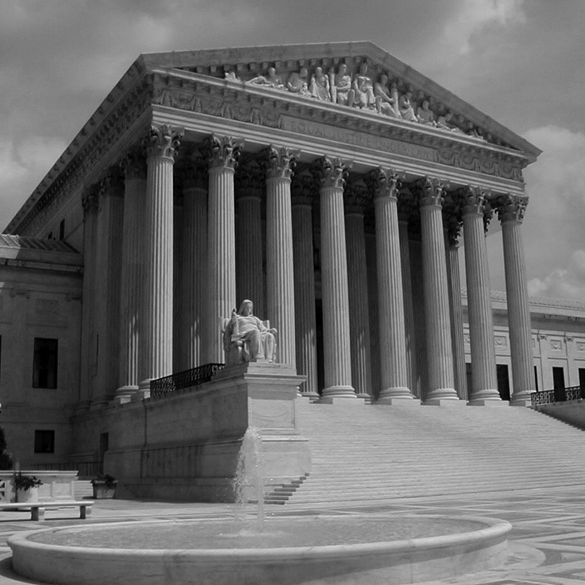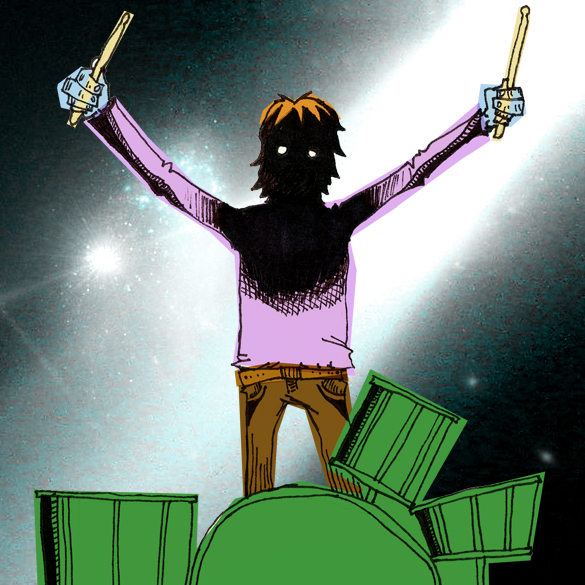“Packing The Court: The Rise of Judicial Power and the Coming Crisis of the Supreme Court,” by James MacGregor Burns (The Penguin Press, 2009). A Review (June 18, 2013):
“I do not forget the position assumed by some,” the new president declared to an expectant, anxious throng assembled in front of the Capitol in Washington for his Inauguration, “that constitutional questions are to be decided by the Supreme Court.” It was March 4, 1861, just four years after the Dred Scott decision. But, Abraham Lincoln went on, “if the policy of the government, upon vital questions, affecting the whole people, is to be irrevocably fixed by decisions of the Supreme Court, the instant they are made . . . the people will have ceased, to be their own rulers, having, to that extent, practically resigned their government, into the hands of that eminent tribunal.” It was the people, Lincoln insisted, who were the “rightful masters” – of president, court, and Constitution.
After Lincoln concluded with a plea for reconciliation between North and South, the aged chief justice of that eminent tribunal came forward to administer the oath of office. To an observer, Roger B. Taney appeared “very much agitated, and his hand shook very perceptibly with emotion. (63-64)
Just four years earlier, for only the second time in its history, a “bench full of Southern lawyers” (64) ignited the Civil War by deciding to exercise a questionable power to have the final say on the legality under the U.S. Constitution of a law duly passed by the people’s representatives in Congress. Following its pro-slavery agenda, chief justice Taney and the majority of the Court threw their authority behind Southern slave holders. They ruled in the infamous Dred Scott case that Congress had no power to enact the great Missouri Compromise of 1820 which had permitted the citizens of the territories to vote democratically on whether their State would be slave or free. Indeed, as a consequence of the Dred Scott ruling, slavery could not even be barred in any of the original thirteen States where it now would resurface. The overreaching Court had declared that “the powers over person and property of which we speak are not only not granted to Congress, but are in express terms denied, and they are forbidden to exercise them. And this prohibition is not confined to the States, but the words are general, and extend to the whole territory over which the Constitution gives it power to legislate.” Shocking our present day sensibilities, the Court said that the only power over slavery which Congress possessed was “that of protecting the rights of the [slave] owner.” (60)
It is no wonder that the defender of inhumane slave holders, the chief justice of the Supreme Court, trembled when President Abraham Lincoln took the oath of office and declared that the people were the rightful masters and keepers of their government, not the courts. Earlier, a Framer of the Constitution, James Madison of Virginia, also had denied that the “judicial authority is to be regarded as the sole expositor of the constitution.” Instead, the ultimate last word belonged to the people. “The authority of constitutions over governments, and of the sovereignty of the people over constitutions, are truths which are at all times necessary to be kept in mind; and at no time perhaps more necessary than the present,” he wrote. (23) Madison uttered these words after the Federalist political party enacted the 1798 Sedition Act which made it illegal to utter words or to put in writing anything that would bring the president or Congress “into contempt or disrepute.” (20) The Federalists and their judicial allies then used criminal prosecutions arising under the Sedition Act in a last desperate attempt to hold onto political power. But they were defeated with the election of President Thomas Jefferson and then the Sedition Act was repealed.
With the election of Thomas Jefferson, the people had spoken and had upheld their right to freedom of speech about political figures. Despite the claims of the Supreme Court in the Dred Scott case, the people again declared their overruling power through the Civil War, despite the legal claims of chief justice Taney and his allies.
While President Lincoln’s legacy insured almost 50 years of Republican presidents, the justices of the Supreme Court who he and his successors appointed betrayed his promises to the people. “In the postwar decades, liberty would be broadened for some – mainly entrepreneurs and speculators, those who possessed or scrambled after riches. Even corporations would come to be endowed with the full dignity of citizenship. But for many millions of others – the poor and working classes and, above all, the freed slaves – the space of freedom would shrink as the nation’s wealth, and power burgeoned. The Union would be reknit, but with the sacrifice of black equality and liberty in the betrayals of Reconstruction.” (80) An enlightening example here is the little known Colfax massacre, called by one historian “the bloodiest single act of carnage in all of Reconstruction.” (87) On Easter Sunday in April of 1873, in a bitter election dispute pitting black Republicans against white Democrats, a local mob of whites eventually killed about 150 blacks while losing only three white lives in the effort. Because of inaction by State officials against the perpetrators, instead 96 white men were indicted under the federal authority of the recently enacted Ku Klux Klan Act which Congress had crafted. Nine men stood trial in a federal court for these crimes but only three were convicted. On their eventual appeal to the Supreme Court, the justices acted unanimously and, “ignoring all the human aspects of the matter, seizing on dubious precedents, and, most significantly, denying the African-American victims the federal guarantees that the Reconstruction Amendments were supposed to have secured them,” they slammed every legal door in the face of federal power which had tried to protect the black man from his former slave holders and their allies. (88)
In this lucid historical narrative, professor Burns next demonstrates the further excesses of what one presidential candidate at the time called “our Imperial Supreme Court,” which “dethrones the people who should be Sovereign and enthrones an oligarchy.” (103) As proof, three decisions in 1895 triggered “an anti-court uproar unmatched since Dred Scott.” (111) One struck down the first peace time federal income tax, on one percent of the populace, who making above $4,000 annually would have had to pay a two percent levy. The Court felt that such a tax on the wealthy would violate “the unvarying law” of civilization, “that the wealth of a community will be in the hands of a few.” (109) The Court also upheld a strike breaking contempt citation against Railway Union leader Eugene Debs by creating out of whole cloth a “special exigency” in the law which allowed federal judicial power to come to the aid of monied interests in labor disputes. But no corresponding federal power ever had been found to help the black race, despite three explicit constitutional amendments which were adopted after the Civil War. (110)
During this period the Court used its disputed and latent judicial powers to hold back progressive forces seeking justice, equity and reform in the political system. Quite clearly, history proves that during this period, the acid test for membership on the Court was the ideology of the justices who abandoned the Republican party’s founding principles, which “still haunts Americans more than a century later,” in the opinion of this respected author. The Civil War “had been framed by many Republicans as a great moral crusade, posing issues on which their party had prospered, securing the power that put most of these justices on the Supreme Court. But from the high bench they had left the momentous civil rights amendments in tatters, before going on to block initiatives to improve the lives of farmers, laborers, and the poor.” (112-13)
With the collapse of the American economy in 1929 and the ensuing Great Depression, the Court next fought tooth and nail to defeat President Franklin Roosevelt’s New Deal and to uphold the monied historic economic order of which the Court was the great defender from 1798 to the 1930s. Ultimately Roosevelt’s court packing scheme failed to make the Court bend to the will of the vast majority of voters. But he was able through attrition and patience to remake the Court in another way by replacing its members in numbers unheard of since George Washington first filled the Court.
From a long historical overview of a reactionary Court, the reader is next reminded that the Roosevelt shift ushered in a brief era of positive reform by the Court in the economic realm and a new focus on rooting and establishing long neglected civil and political rights for the black man and other citizens. The reader learns that “for the first time, the Supreme Court was in the vanguard of change, driving the forces of reform both in government and at the grassroots in the 1960s.” (194)
But we later see that what some may consider the heyday of the Court was an historical aberration. During the 1950s and 1960s, under the leadership of chief justice Earl Warren, the Court acted with a conscience and not as a choke point for reform. But that tide was turned, starting with President Richard Nixon and others, who to the present day succeeded in making the Court once again a defender of economic and statist interests over the Bill of Rights, the Reconstruction Amendments, and other checks on excessive corporate and governmental power. “Looking to the Supreme Court for continuing liberal leadership was always a bad bet,” notes the author. (194) The historical rule is that of a conservative Supreme Court. And so professor Burns calls the present period one of Republican activism and the hard right turn of the Cheney-Bush Court.
Moreover, we also learn that at no time during the Warren Court era did it ever renounce its frequently used reserve power over the people and the Congress which President Lincoln and James Madison had challenged. The misuse of that power of judicial review which strikes down laws of Congress for the benefit of the rich and powerful is the primary lesson taught by this comprehensive history.
But professor Burns goes beyond reminding us of the danger of placing the people’s political hopes in an institution known for its oligarchic and reactionary political role. In his concluding chapter, he also advocates for the necessary steps which he believes would end judicial supremacy, after countless failed attempts to do so over more than 200 years. He argues that “it is emphatically the province and duty of the American people, not of the nine justices of the United States Supreme Court, to say what the Constitution is. A national reappraisal of the all-powerful court chosen by judicial roulette is crucial if American democracy is to meet the rising challenges of the twenty-first century.” (259) And so the next time a president is faced with the Court repeatedly striking down vital progressive legislation, the author suggests that the president should announce that he will continue to faithfully execute the law which the Court has vetoed unconstitutionally. He should declare that the power which the Court exercises to veto a law enacted by the democratic branches of the government is not found anywhere in the Constitution but instead draws its origin from an illegitimate decision in 1803 by the Court in Marbury v. Madison. “The president would invite the partisans of judicial supremacy to try to write that authority into the Constitution by proposing a constitutional amendment.” Then the people would decide whether the Court should have such a power or whether judicial supremacy should be rejected. (253).
The author acknowledges that his proposal would be risky, which is an understatement. This reviewer wonders if a citizenry which some may say is undereducated on principles of basic American civics, in addition to the historical lessons found in this book, would be up to the task. Or would a Congress which has abdicated more and more of its powers to an Imperial presidency assume responsibility for defending constitutional freedoms instead of leaving that responsibility to a conservative Court. And then the response from the Court would be formidable also. The power to hold the president or executive branch officials in criminal or civil contempt of court, and to coerce obedience through fines or imprisonment, would have to be tested. Or what of impeachment efforts directed at the president by the opposite political party?
Professor Burns breadth and depth of understanding of the history, law and politics surrounding the Supreme Court is second to none. Any citizen or voter will greatly benefit from this highly readable refresher course in the dominant unanticipated role of the Court in the American political system and how its operation in the present political culture denies supremacy over major political issues to the avowedly political branch, the Congress. This result is contrary to the intentions of the Framers of our constitutional system and unimpeachable commentators like Abraham Lincoln and James Madison.
The author argues that the genius of the American constitutional framework is the continuing political dialog it generates because the separation of powers in the legislative and political branches and the party system require sustained effort to build coalitions to enact social change. Coalition building requires compromises and compromises protect varied interests and citizens during the legislative process. But the results of this process were never intended to be vetoed by nine justices who would have the final say on the important legislative decisions facing the political community. Professor Burns ably presents much food for thought on these vital issues, and his book deserves to be widely read and debated.


